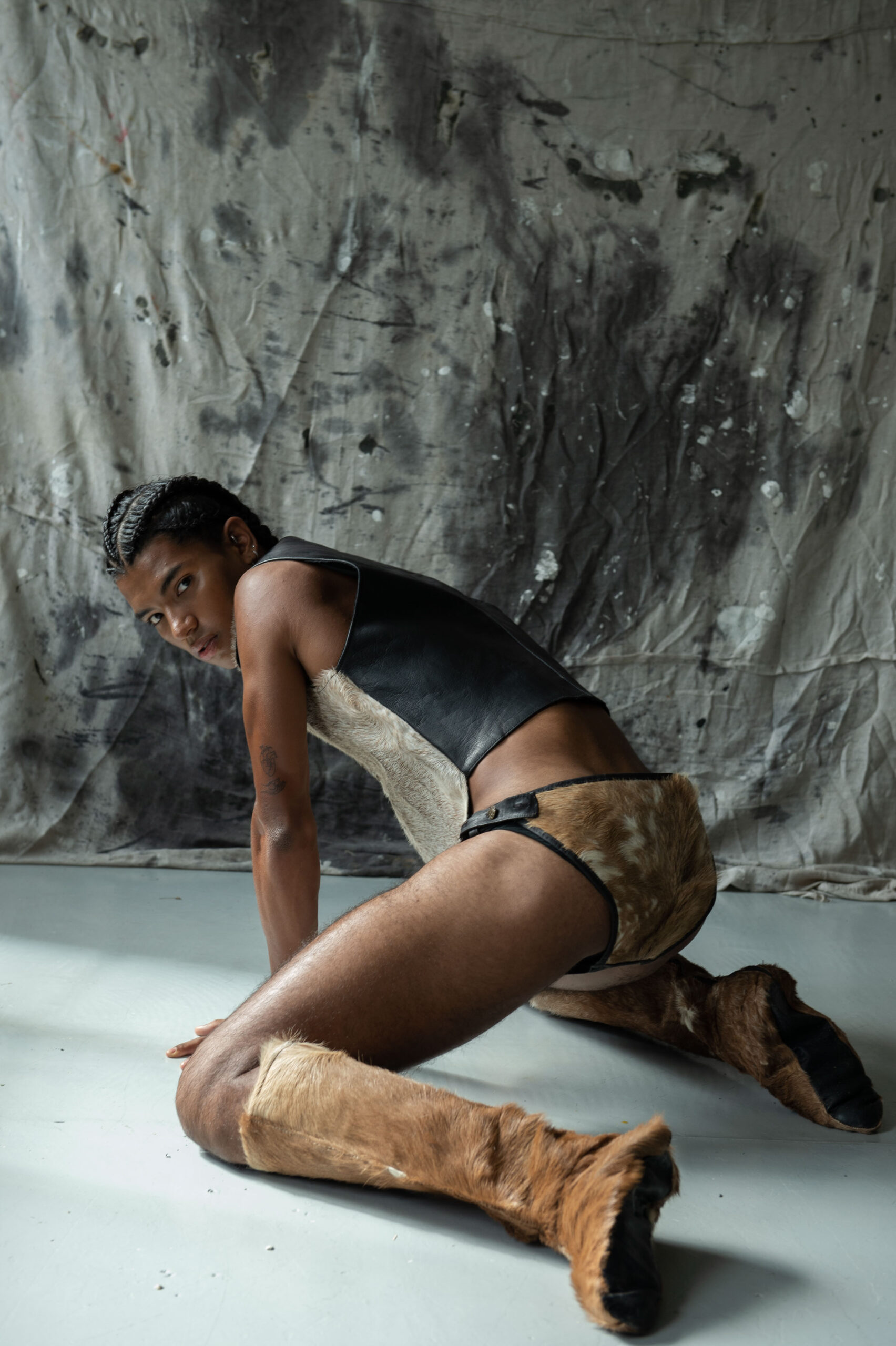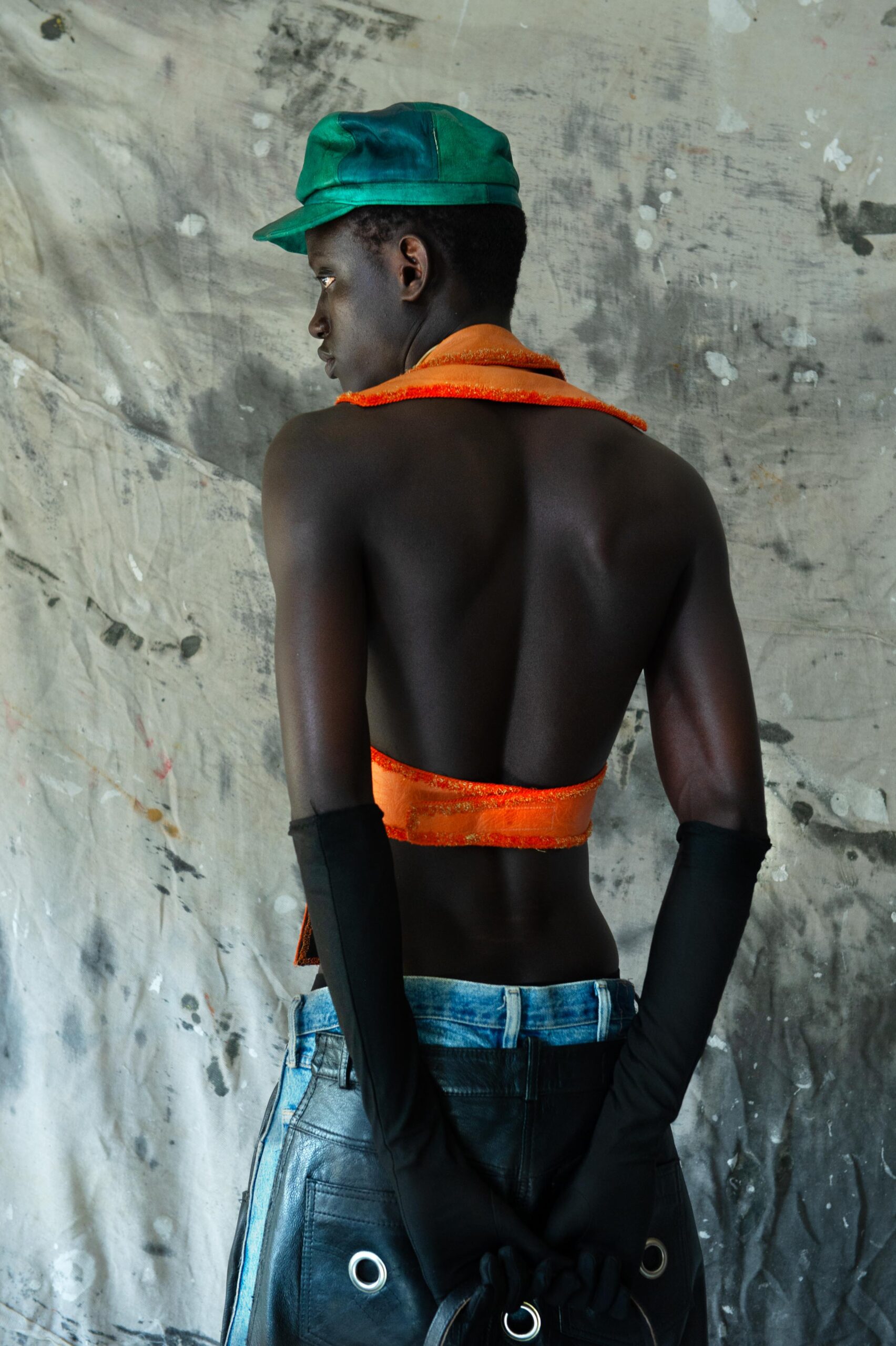Kusi Kubi is an Accra and London-based stylist, designer, and creative director popular for founding sustainable clothing line - PALMWINE IceCREAM, a previous stint as fashion director for MANJU Journal, and numerous other creative endeavors.
His work is centered around the utilization of pre-existing materials, most particularly deadstock, secondhand finds and craftsmanship, with consideration for environmental impact as well as an expansive approach to gender-expression. Kusi's work also draws inspiration from day-to-day storytelling, and is crafted to inspire feelings of fantasy and escape.
Kusi is an extremely dedicated individual, and it is made obvious by his devotion to honing his craft and interrogating routes through which fashion assumes a more sustainable and eco-friendly state. Making use of deadstock fabrics, denim, upcycled leather, sandals made from old car tires and animal hide, Kubi looks to safeguard his environment and ecosystem with his productions. Above all, Mii La should be seen as a call to dream, and to “breathe new life into the tired, the heavy, the wasteland - to transform derelict beauty”, as Kubi says. It is intended to inspire the creation of the new from the old, bring life to clothes that have died, as a conscious effort to reduce waste and change the way it’s audience views ‘Expiration’.
On this interview, Kusi describes the responsibility of owning an environmentally conscious fashion brand.
Designing and creating authentic fashion from an environmentally conscious standpoint is definitely a markedly different journey from just designing and creating fashion. What has that journey been like for you?
For Season 2 we worked and experimented with organic leather which are sustainable sourced within farms and communities across Ghana, how to treat and maintain as well as understanding the techniques of working with natural leather. Production this season compared to season one has been slower and this is all because working with natural leather with a small team and having to navigate it all can be challenging. However with time, my team and l have managed to understand and solve most of the challenges.We look forward to the launch of our E-store this month!
Regarding your re-see of your PWIC 2023 Collection, tell me why this is important to you as a brand?
As a sustainable brand, we showcase one collection a year, while we find other creative ways to reinvent the collection throughout the year. I think having multiple collections a year for a sustainable brand might be a big jump. For PWIC It's about creating pieces which tell stories for a longer period of time .There are so many stories one can tell and do with a collection of 35 looks throughout the year!
When did you realize you wanted to make environmentally conscious clothing and what were the factors that made you opt for more environmentally sustainable material?
Well, when I started the brand, I wanted to create pieces which were unique and give something more to the consumer, some sort of connection between the clothing and the owner. However, with Accra having one of West Africa’s biggest thrift markets, I can’t help but notice how many leftover garments are received on a weekly basis. I believed it was important for me to play my part somehow to reduce further mass consumption. Our Aim at PWIC is not to saturate the market but produce clothing for people who believe in what we do and stand for.
You cite the city of ‘Tamale’ as a major inspiration for this collection, can you give a little more detail about that?
Tamale, the capital city of the Northern Region of Ghana and the distinctively resourceful re-use and re-working hides for a number of uses: bags, wallets, drums, sandals, wall arts and even for a hunters bow and arrow and as a talisman for protection. My Personal experience and observations on a visit to the region inform a manifold for the collection’s development and creative process. Using deadstock fabrics, denims, upcycled leathers, sandals made from old car tyres and hide and working with local artisans from Tamale who dye dry the hide in the sun for a number of days, where it is then treated. All the leathers and skins used in the collection are unprocessed, except for dying and remarkably nearly all of the garments made have no lining - maintaining the hide in its rawest state ensures the ability of optimum re-use of these materials.
Kusi Kubi is an Accra and London-based stylist, designer, and creative director popular for founding sustainable clothing line - PALMWINE IceCREAM, a previous stint as fashion director for MANJU Journal, and numerous other creative endeavors.
His work is centered around the utilization of pre-existing materials, most particularly deadstock, secondhand finds and craftsmanship, with consideration for environmental impact as well as an expansive approach to gender-expression. Kusi's work also draws inspiration from day-to-day storytelling, and is crafted to inspire feelings of fantasy and escape.
Kusi is an extremely dedicated individual, and it is made obvious by his devotion to honing his craft and interrogating routes through which fashion assumes a more sustainable and eco-friendly state. Making use of deadstock fabrics, denim, upcycled leather, sandals made from old car tires and animal hide, Kubi looks to safeguard his environment and ecosystem with his productions. Above all, Mii La should be seen as a call to dream, and to “breathe new life into the tired, the heavy, the wasteland - to transform derelict beauty”, as Kubi says. It is intended to inspire the creation of the new from the old, bring life to clothes that have died, as a conscious effort to reduce waste and change the way it’s audience views ‘Expiration’.
On this interview, Kusi describes the responsibility of owning an environmentally conscious fashion brand.
Designing and creating authentic fashion from an environmentally conscious standpoint is definitely a markedly different journey from just designing and creating fashion. What has that journey been like for you?
For Season 2 we worked and experimented with organic leather which are sustainable sourced within farms and communities across Ghana, how to treat and maintain as well as understanding the techniques of working with natural leather. Production this season compared to season one has been slower and this is all because working with natural leather with a small team and having to navigate it all can be challenging. However with time, my team and l have managed to understand and solve most of the challenges.We look forward to the launch of our E-store this month!
Regarding your re-see of your PWIC 2023 Collection, tell me why this is important to you as a brand?
As a sustainable brand, we showcase one collection a year, while we find other creative ways to reinvent the collection throughout the year. I think having multiple collections a year for a sustainable brand might be a big jump. For PWIC It's about creating pieces which tell stories for a longer period of time .There are so many stories one can tell and do with a collection of 35 looks throughout the year!
When did you realize you wanted to make environmentally conscious clothing and what were the factors that made you opt for more environmentally sustainable material?
Well, when I started the brand, I wanted to create pieces which were unique and give something more to the consumer, some sort of connection between the clothing and the owner. However, with Accra having one of West Africa’s biggest thrift markets, I can’t help but notice how many leftover garments are received on a weekly basis. I believed it was important for me to play my part somehow to reduce further mass consumption. Our Aim at PWIC is not to saturate the market but produce clothing for people who believe in what we do and stand for.
You cite the city of ‘Tamale’ as a major inspiration for this collection, can you give a little more detail about that?
Tamale, the capital city of the Northern Region of Ghana and the distinctively resourceful re-use and re-working hides for a number of uses: bags, wallets, drums, sandals, wall arts and even for a hunters bow and arrow and as a talisman for protection. My Personal experience and observations on a visit to the region inform a manifold for the collection’s development and creative process. Using deadstock fabrics, denims, upcycled leathers, sandals made from old car tyres and hide and working with local artisans from Tamale who dye dry the hide in the sun for a number of days, where it is then treated. All the leathers and skins used in the collection are unprocessed, except for dying and remarkably nearly all of the garments made have no lining - maintaining the hide in its rawest state ensures the ability of optimum re-use of these materials.







